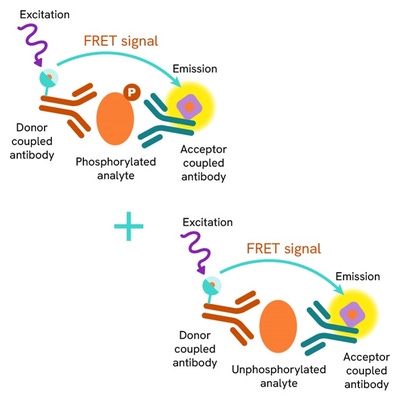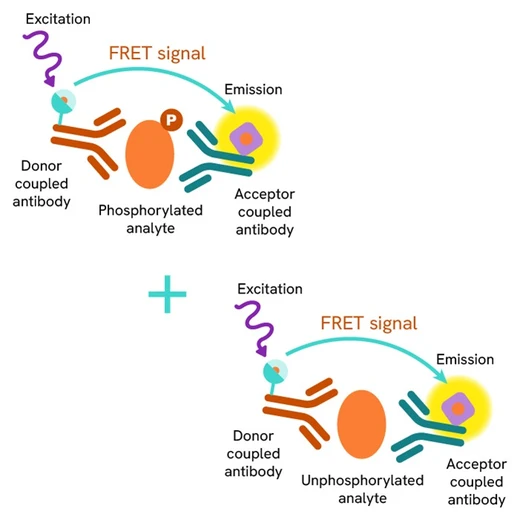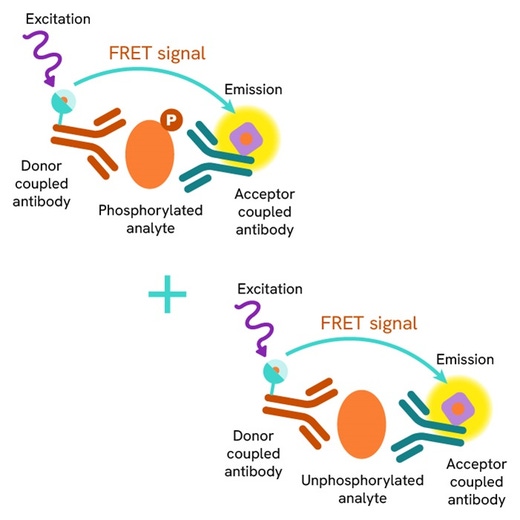

HTRF Human and Mouse Total HTT Detection Kit, 500 Assay Points








| Feature | Specification |
|---|---|
| Application | Protein Quantification |
| Sample Volume | 10 µL |









Product information
Overview
Huntingtin (HTT) is a cytoplasmic protein which is highly expressed in the brain, and whose anti-apoptotic role is critical for neuronal survival.
The wild-type (WT) protein has a functional structure, with a "normal" polyglutamine (polyQ) domain containing less than 36Q. The mutant HTT protein harbors an abnormally long polyQ tract (> 36Q), which causes the aggregation of the no longer functional protein. HTT aggregation leads to the selective neuronal cell death responsible for Huntington's Disease.
How it works
Total HTT assay principle
The Total HTT assay is based on a TR-FRET sandwich immunoassay involving two specific antibodies, one labelled with Tb3+ cryptate (donor) and the other with d2 (acceptor). Both antibodies bind to soluble Total HTT (WT & mutant forms), and the donor-acceptor proximity enables a fluorescent TR-FRET signal. The intensity of the signal is directly proportional to the concentration of soluble Total HTT present in the sample (cell lysate or tissue lysate).

Total HTT assay protocol
The Total HTT assay can be run in a 96- or 384-well low volume white detection plate (20 µL final). As described here, samples (cell/tissue lysates) or standards are dispensed directly into the assay plate for the detection of Total HTT by HTRF® reagents. The antibodies labelled with HTRF fluorophores may be pre-mixed and added in a single dispensing step. No washing steps are needed. The protocol can be further miniaturized or upscaled by simply resizing each addition volume proportionally.

Assay details
Technical specifications of Total HTT kit
| Sample size | 10 µL |
|---|---|
| Final assay volume | 20 µL |
| Time to results | Overnight at RT |
| Kit components | Frozen control lysate, detection antibodies, buffers & protocol |
| LOD & LOQ (in Lysis Buffer #2) | 1.6 ng/mL & 6.3 ng/mL |
| Assay range | 6.3 - 750 ng/mL |
| Species cross-reactivity | Human, mouse, & rat |
| Assay specificity | Soluble wild-type & mutant HTT forms |
Assay validation
Analysis of brain tissue samples collected from WT and mutant HTT mouse models
The HTRF Total HTT assay was validated on brain tissues collected from premanifest zQ175 mice and wild-type (WT) littermates, the most extensively studied preclinical knock-in mouse model used for Huntington’s disease (Landles C. et al, Brain Commun. 2021; 3(1):fcaa231). The cortex and cerebellum tissues of three WT mice (#1, #2, & #3) and three mutant zQ175 mice (#4, #5, & #6) were lysed following the procedure given in the kit’s package insert. Briefly, a 5% (w/v) tissue homogenate was prepared using ice-cold 1X lysis buffer #2 supplemented with protease inhibitors, and the insoluble fraction of the lysate containing putative mutant HTT aggregates was removed by centrifugation. The supernatants containing soluble HTT proteins were analysed using the HTRF Total HTT assay and the HTRF Mutant HTT assay (Cat# 64HTTMPEG/H). To check that the protein extraction was similar for each sample, the level of the housekeeping protein GAPDH was also measured using the HTRF GAPDH assay (Cat# 64GAPDHPEG/H). To ensure that the detected analyte was assessed at a concentration compatible with the assay’s linear range, the lysates were pre-diluted in 1X lysis buffer #2 supplemented with protease inhibitors just before detection (1/4 for Total HTT assay, 1/8 for Mutant HTT assay, and 1/100 for GAPDH assay).
The levels of GAPDH were similar for all samples (green bars), demonstrating that the tissue lysates contained comparable total protein contents. No signal was obtained with the Mutant HTT assay on samples collected from WT mice, whereas the soluble mutant protein was clearly detected in cortex and cerebellum tissues collected from premanifest zQ175 mice (blue bars). As expected, the soluble total HTT protein (WT and mutant forms) was measured in all lysates (red bars), and its levels correlate well with the small variations observed for the Mutant HTT protein levels.


Side-by-side comparison of HTRF and Western Blot for the analysis of Mutant and Total HTT in brain tissues
A side-by-side comparison of HTRF Mutant & Total HTT assays and the Western Blot technique was performed on several brain tissues (cortex, hippocampus, and cerebellum) collected from one WT mouse and one premanifest zQ175 mouse. Tissue lysates were prepared as described in the previous section and the supernatants containing soluble HTT proteins were analysed, either by HTRF using the HTRF Mutant & Total HTT assays, or by Western Blot. To ensure that the detected analyte was assessed at a concentration compatible with the assay’s linear range for each detection method, the lysates were pre-diluted in 1X lysis buffer #2 supplemented with protease inhibitors just before detection (for HTRF: 1/8 for Mutant HTT assay and 1/4 for Total HTT assay; for Western Blot: 1/20 for both assays).
The results obtained using HTRF Mutant & Total HTT assays are comparable with those obtained by Western Blot. With both methods, no soluble mutant HTT was detected in brain tissues collected from WT mice, whereas the protein was properly measured in all samples collected from premanifest zQ175 mice. As expected, the soluble total HTT protein (WT and mutant forms) was measured in all lysates, and its levels correlate well with the differences observed for the Mutant HTT levels among the three different brain tissues.

Validation of Total HTT assay on human and mouse neuroblastoma cell lines
Human SH-SY5Y and mouse Neuro-2a neuroblastoma cell lines were cultured in T175 flasks in complete culture medium at 37°C-5% CO2. After a 48h incubation, the cells were lysed with 3 mL of lysis buffer #2 (1X) for 30 minutes at RT under gentle shaking. After centrifugation of the cell lysates, the supernatants were serially diluted in lysis buffer #2 (1X), and 10 µL of each dilution were transferred into a low volume white microplate before the addition of 10 µL of HTRF Total HTT detection reagents.
The HTRF Total HTT assay was suitable for the measurement of the levels of soluble WT human and mouse HTT proteins present in SH-SY5Y and Neuro-2a cell lysates.


Specifications
| Application |
Protein Quantification
|
|---|---|
| Automation Compatible |
Yes
|
| Brand |
HTRF
|
| Detection Modality |
HTRF
|
| Lysis Buffer Compatibility |
Lysis Buffer 2
Lysis Buffer 3
|
| Molecular Modification |
Total
|
| Product Group |
Kit
|
| Sample Volume |
10 µL
|
| Shipping Conditions |
Shipped in Dry Ice
|
| Target Class |
Biomarkers
|
| Target Species |
Human
Mouse
|
| Technology |
TR-FRET
|
| Therapeutic Area |
Neuroscience
|
| Unit Size |
500 assay points
|
Video gallery
Resources
Are you looking for resources, click on the resource type to explore further.
Discover the versatility and precision of Homogeneous Time-Resolved Fluorescence (HTRF) technology. Our HTRF portfolio offers a...
This guide provides you an overview of HTRF applications in several therapeutic areas.
Neurodegenerative diseases, such as Alzheimer’s, Parkinson’s, and Huntington’s, are complex disorders that affect millions...
Dive deeper into Huntington’s disease research with this application note
Huntington’s disease is a neurodegenerative disorder that...
Targeted protein degradation (TPD) offers a promising approach for treating neurodegenerative diseases by selectively degrading...


Loading...
How can we help you?
We are here to answer your questions.






























